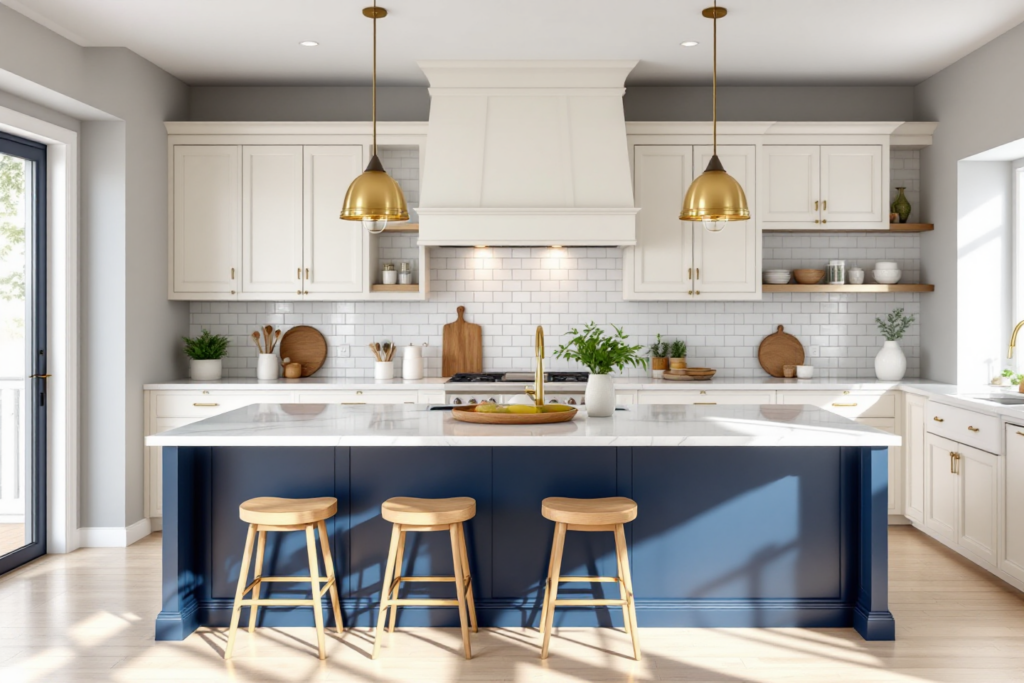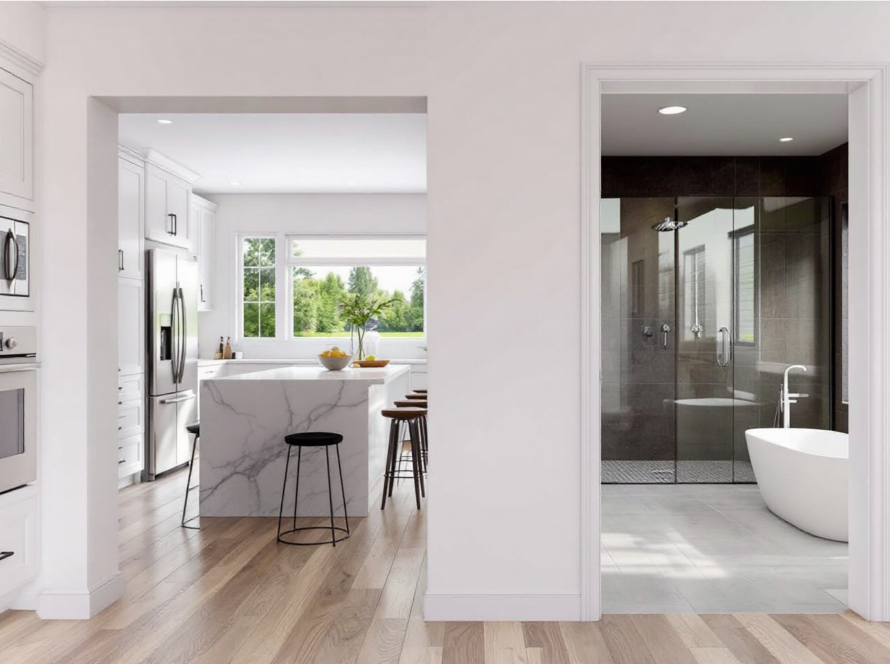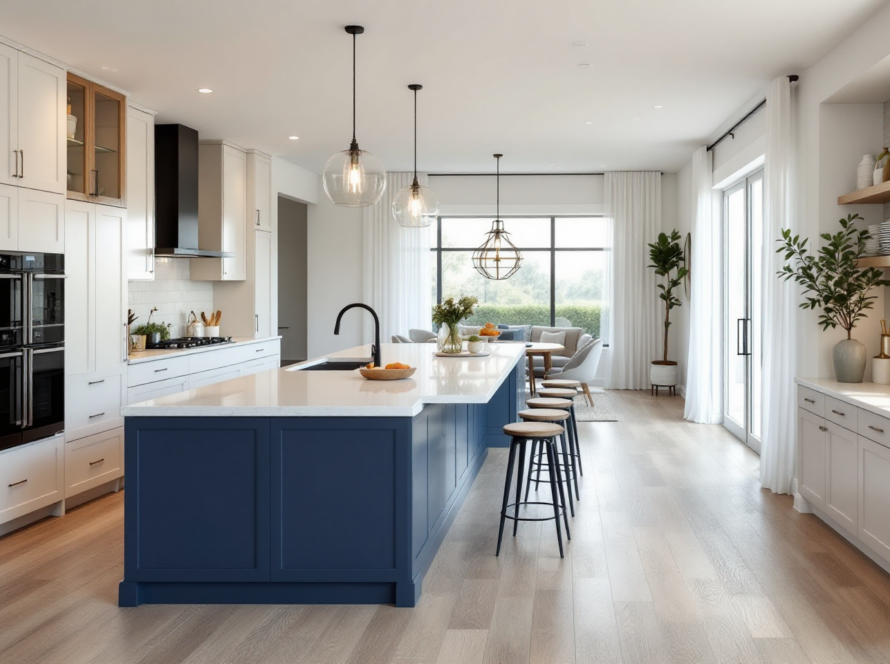Design trends come and go, but some styles are forever. If you’ve ever stood in the middle of your kitchen thinking, “I love the sleek modern look, but I also can’t part with those classic elements,” you’re not alone. The art of blending modern and traditional styles is the secret sauce to creating a timeless kitchen or bathroom—one that doesn’t age out faster than your last smartphone upgrade.
This hybrid design trend—also known as “transitional design”—combines the best of both worlds: the warmth and charm of traditional elements with the crisp, clean lines of modern aesthetics. And the result? A space that feels intentional, elegant, and enduring.
TLDR – Quick Guide
- Keep a cohesive color palette to tie both styles together.
- Mix materials and textures—think marble counters with matte black fixtures.
- Use classic forms with modern finishes, like shaker cabinets in a glossy lacquer.
- Incorporate statement lighting to bridge the two aesthetics.
- Balance ornate with minimalism for a clean yet inviting look.
Implementation Tactics
1. Start with a Neutral Base
When you’re combining modern and traditional styles, the safest way to avoid a visual clash is to start with neutral tones. Think whites, grays, beiges, or soft earth tones. These colors act as a blank canvas that allows other stylistic elements to shine without overwhelming the senses.
Pro tip: Benjamin Moore’s “Classic Gray” or Sherwin Williams’ “Agreeable Gray” are versatile crowd-pleasers.
2. Choose Hybrid Fixtures and Finishes
Think brushed nickel faucets with a vintage silhouette. Or how about a freestanding clawfoot tub next to ultra-sleek, floor-to-ceiling glass shower doors? Mixing styles doesn’t mean going rogue—it means being selective.
- Cabinetry: Go traditional with shaker or inset panels, but pair them with modern handles in matte black or gold.
- Lighting: Use chandeliers with clean lines or sconces that echo vintage lanterns but with LED technology.
Check out Schoolhouse Electric or Rejuvenation for fixtures that marry the old and new effortlessly.
3. Balance Open Space and Detail
Modern design loves open layouts and clean surfaces. Traditional styles lean toward more structured zones and ornate detailing. Marrying the two means honoring both:
- Use open shelving next to glass-front cabinets
- Add crown molding but keep wall décor minimal
- Use subway tiles (a classic) in unexpected patterns (a modern twist)
4. Layer Textures and Materials
A major key to making modern and traditional styles coexist is by layering textures. If your bathroom has glossy ceramic tile, introduce a rustic wooden vanity or natural stone countertop. In kitchens, mix stainless steel appliances with a farmhouse sink or butcher block island.
Example: Capital Kitchen & Bath does this masterfully by pairing quartz countertops with classic tile backsplashes and vintage-inspired hardware (view their work).
5. Keep Technology Invisible
Modern technology is great—until it makes your charming kitchen look like a spaceship. Look for built-in, hidden, or subtly integrated appliances. In bathrooms, use touchless faucets or smart mirrors that look like traditional framed mirrors.
6. Embrace Symmetry and Simplicity
Traditional spaces often use symmetry for balance, while modern design loves simplicity. Fuse the two by:
- Placing identical sconces on either side of a mirror
- Centering your island lighting
- Minimizing the number of materials and colors used
Key Takeaways
- Blending modern and traditional styles creates a timeless design.
- Start with a neutral palette, then add texture and materials to connect both worlds.
- Choose transitional hardware, lighting, and cabinetry to balance form and function.
- Keep the tech subtle and prioritize symmetry and simplicity.
FAQs
- What are the key elements of transitional design?
Transitional design merges traditional and modern elements—think classic architecture with contemporary finishes, or vintage fixtures paired with sleek surfaces. - Can I blend modern and traditional styles in a small bathroom or kitchen?
Yes! In small spaces, keep the color palette light and cohesive. Focus on mixing finishes and using hybrid furniture or fixtures that embody both styles. - What materials work best when combining styles?
Go for materials with timeless appeal like marble, wood, and matte metals. Mixing warm wood tones with clean quartz or brushed brass is a winning combo. - How do I keep the look from feeling cluttered or mismatched?
Stick to a consistent color scheme, limit your material types, and ensure that every piece has a reason for being there—both stylistically and functionally. - Are there any styles that don’t blend well with modern or traditional?
Super-industrial or ultra-rustic styles may clash unless carefully curated. Transitional design works best when both modern and traditional elements are intentionally chosen to harmonize.



